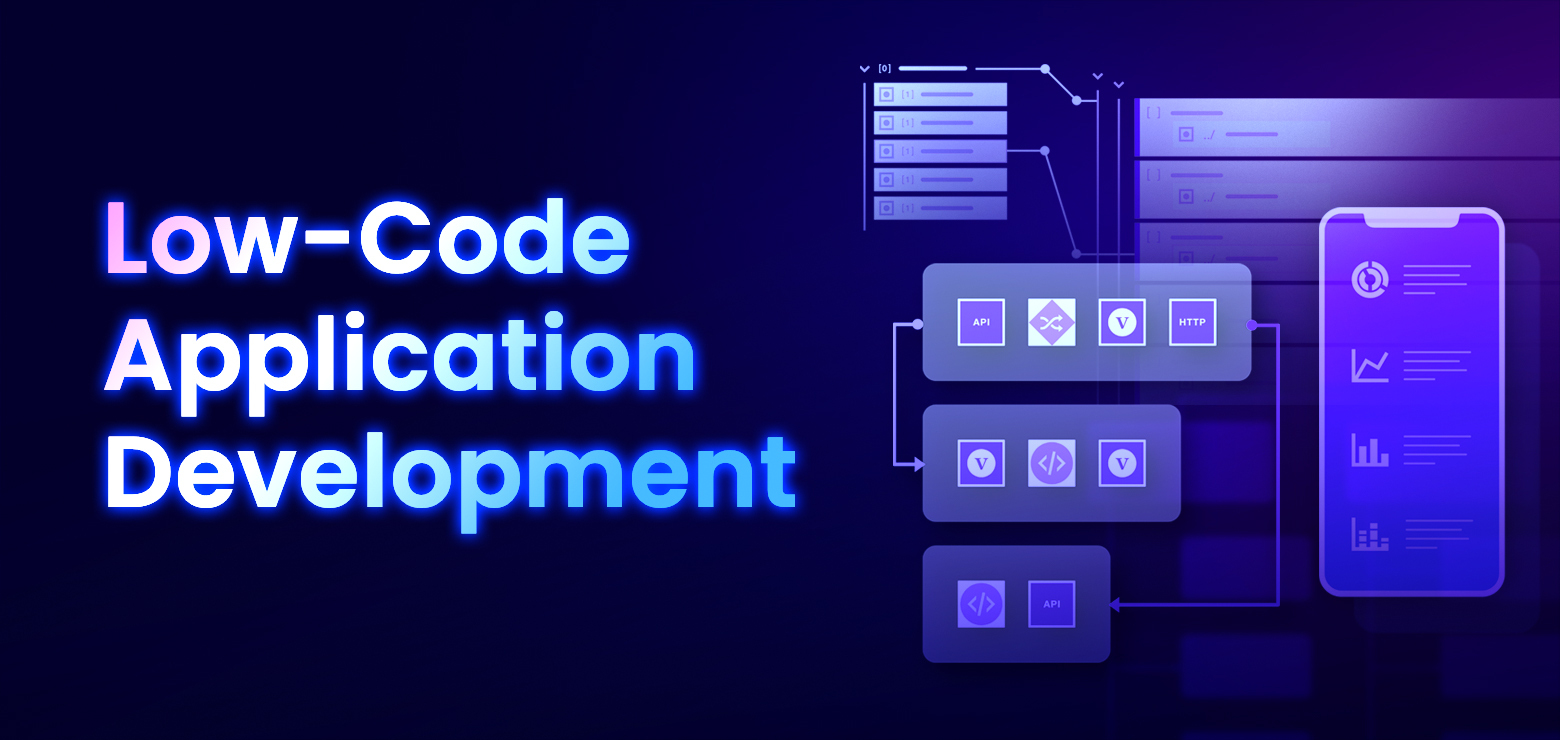Low-code application development platforms are an integral part of digital transformation initiatives, enabling organizations to innovate faster, adapt to change, and deliver value to customers and stakeholders in today’s digital age.
There is no one-size-fits-all platform. Adopting multiple solutions is more common than not, and it’s about finding the right tools to solve your business pains.
So what is low-code, and how do businesses use low-code development platforms to drive innovation and streamline processes? Jitterbit’s industry experts answer these questions and more.
What is low-code?
Low code is an approach to software development that uses a graphical user interface and pre-built components to design, develop, and deploy applications faster and more efficiently than traditional manual coding. This is particularly appealing to individuals with limited or no programming skills, but it can also help create more efficient workflows for experienced developers.
What is a low-code application development platform?
Low-code application development platforms (LCAP) are tools that provide guided development pathways with drag-and-drop interfaces, pre-built templates, and other visual tools to minimize the amount of code required to build business apps. These platforms simplify and speed up complex development processes, like designing user interfaces, defining business logic, and integrating various components.
With this limitless potential for creation, customization, and automation, companies of all sizes, across all industries, can benefit from using low-code app development tools.
Examples and use cases
Low-code development is transforming the way organizations handle various business processes, making them more efficient and effective. Below are some specific examples of how low-code application platforms can be utilized across different scenarios:
→ Dynamic Employee Onboarding
Low-Code Solution: A low-code application can automatically generate personalized onboarding checklists, assign tasks to relevant departments, and track progress in real-time. This ensures a seamless and efficient onboarding experience for new hires, reducing administrative burden and improving employee satisfaction from day one.
→ Real-Time Supply Chain Management
Low-Code Solution: A low-code platform can integrate data from various sources such as suppliers, logistics providers, and inventory systems into a single dashboard. This enables supply chain managers to monitor shipments, track inventory levels, optimize manufacturing floors, and anticipate potential disruptions. Automated alerts and predictive analytics powered by low-code development platforms can further enhance responsiveness, ensuring that supply chain operations remain smooth and efficient.
→ Regulatory Compliance Tracking
Low-Code Solution: Businesses can develop applications that monitor regulatory changes, maintain compliance records, and generate audit-ready reports. This not only reduces the risk of non-compliance but also saves time and resources spent on manual compliance management tasks.
→ Automated Marketing Campaigns
Low-Code Solution: Low-code development platforms can automate the entire campaign lifecycle, from planning and execution to monitoring and analysis. Marketers can design workflows that integrate email marketing, social media, and other digital channels, ensuring consistent messaging and timely execution. Real-time analytics provided by low-code applications allow marketers to track campaign performance, make data-driven adjustments, and maximize ROI.
Other common use cases for low-code app development include:
- Forms / Workflows
- Dashboards / Analytics
- CRM / CMS
- Intranets / Customer Portals
- Inventory Management
- Workforce Management
- Compliance
- Procurement / Transactional
- Multi-Tenant
- Mission Critical
Who can build with low-code?
Low-code platforms enable professional developers and citizen developers (business users with limited programming skills) to rapidly develop and deploy applications. These platforms help address productivity issues, skill shortages, and business project backlogs.
| Who is a Professional Developer? | Who is a Citizen Developer? |
| A professional developer is a skilled software expert with knowledge of various programming languages and methodologies, capable of front-end and back-end development of high-quality software solutions. Professional developers can extend low-code applications with custom code, which is sometimes needed for custom complex solutions. |
A citizen developer using a low-code platform can build their own applications with limited or no coding skills and operate independently of the IT department. Being closer to end-users, they craft user-centric solutions that enhance user satisfaction and adoption rates. They often contribute to lowering development costs and reducing reliance on IT departments. |
What are the benefits of using a low-code application platform?
Using a low-code development platform offers numerous benefits for organizations of all sizes and industries, including:
-
Speed to deployment
Getting to market faster means earning revenue faster. With ever-changing business conditions and needs, agility is key.
-
Cost savings
Extreme improvement in time to value. Expect an 80% or greater reduction in expensive resources and development timeframes.
-
Risk mitigation
Businesses can focus on solutions instead of technologies used to build them.
-
Flexibility
Load data faster and start building applications immediately with full flexibility to adjust on the fly.
-
Collaboration & accessibility
Bridge the gap between business leaders and IT in your organization. With minimal training required, everyone across the organization can contribute to the application development process.
-
Enhanced integration
Allows for seamless integration with third-party services, APIs, and legacy systems, enabling businesses to utilize their current infrastructure and data sources.
-
Improve governance and compliance
Organizations can uphold data integrity and safeguard sensitive information through built-in capabilities.
-
Improved customer and employee experiences
Respond to user needs and feedback promptly while delivering a customized experience that promotes engagement.
Learn more about Jitterbit’s low-code application platform
Why is low-code critical for solving business challenges fast?
Want to get ahead of your competitors? Solving both your customers’ and your own business problems quickly and easily, with minimal high-cost resources and time, should be a no-brainer.
If nothing else, the past few years have taught us businesses need to be agile to react to unforeseen and unprecedented challenges quickly. Enterprises and all businesses alike need to examine opportunities for streamlining operations to remain competitive.
Process automation is key for digital transformation, and even greater benefits exist for businesses that can automate, or even hyperautomate, multiple processes. Turning manual, multi-step workflows into streamlined, automated processes provides measurable results in cost, resource, and time savings. Low-code solutions, like Jitterbit’s low-code application builder, App Builder (formerly Vinyl), provide the optimal framework to quickly and successfully automate processes across your business.
With the right low-code development platform, you can put the foundation in place to solve business needs rapidly by building custom applications.
Where do some low-code platforms fall short?
Although the benefits of using low-code can be limitless, many platforms fall short of delivering the expected results. When selecting a low-code solution, you shouldn’t have to sacrifice complexity and functionality for ease of use.
Security is a key factor to consider when looking at low-code application platforms. Research the platform company’s security policies, and how it applies to their platform. Security should be front and center in any low-code platform, with the ability to scale along with your business needs every step of the way.
Another key factor to consider is whether the platform offers the hosting flexibility to meet your business’ needs. Some providers lock you into their cloud. App Builder offers flexible options, allowing you to host in our cloud, in your own private cloud, or deploy and host on-premise.
Tips for choosing the best low-code app development platform
At a minimum, we recommend selecting a platform that offers the following features:
- A predictable, consistent pricing model
- Full integrations to all systems and data sources
- Integrated security standards for users, data, applications, and the platform
- Customer deployment options (on-premise, hosted cloud, or private cloud)
- User-defined workflows with notifications
- Multilingual translation support
- Intuitive visual design tools
- Release management
- Audit logs and monitoring
- Application lifecycle management
- Responsive design
- AI assisted development
The future of low-code development
In 2023, the low-code application development platform market was estimated at $24.83 billion—with increased competition, the market is anticipated to be worth $86.92 billion by 2027 and $101.68 billion by 2030.
As the market continues to grow, the future of low-code app development holds immense promise to transform the way businesses innovate, iterate, and adapt.
Here’s a look into what lies ahead:
-
AI-powered low-code application development platforms
AI coding assistants provide developers with intelligent suggestions, real-time error detection, and autocomplete features, significantly speeding up coding tasks. Additionally, AI-powered conversational interfaces allow developers to interact with the platform using natural language.
-
Greater focus on platform developer experience
More intuitive interfaces are being designed to simplify navigation and reduce the learning curve for new users. Pre-built templates for common application scenarios and a library of pre-built components enable developers to quickly assemble applications without the need for extensive coding.
-
Stronger collaboration tooling for development teams
Advanced version control capabilities, such as code branching, allow teams to work on features and fixes simultaneously without disrupting each other’s work. This fosters more efficient collaboration, reduces the risk of code conflicts, and accelerates the development cycle.
-
Improved security and governance
The latest low-code platforms offer robust capabilities for building native mobile applications, enabling businesses to create feature-rich apps that leverage device-specific capabilities.
Why choose Jitterbit’s low-code application builder?
As a leading low-code application development platform, Jitterbit App Builder (formerly Vinyl) simplifies building scalable, end-to-end applications that easily integrate with new and existing systems, including legacy systems. Designed for organizations to solve complex business problems at scale, App Builder empowers anyone to create fully-integrated, bi-directional applications in weeks. Powerful enough for full stack developers and intuitive enough for citizen developers and business technologists, App Builder enables you to build secure apps that run on any device, automate any business process, and integrate any data source–no coding required. To learn more about App Builder, schedule a demo with an expert today.




